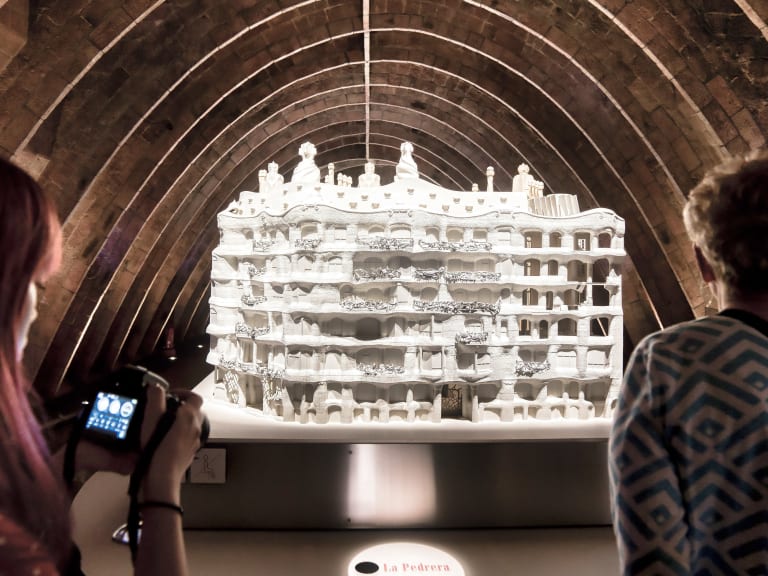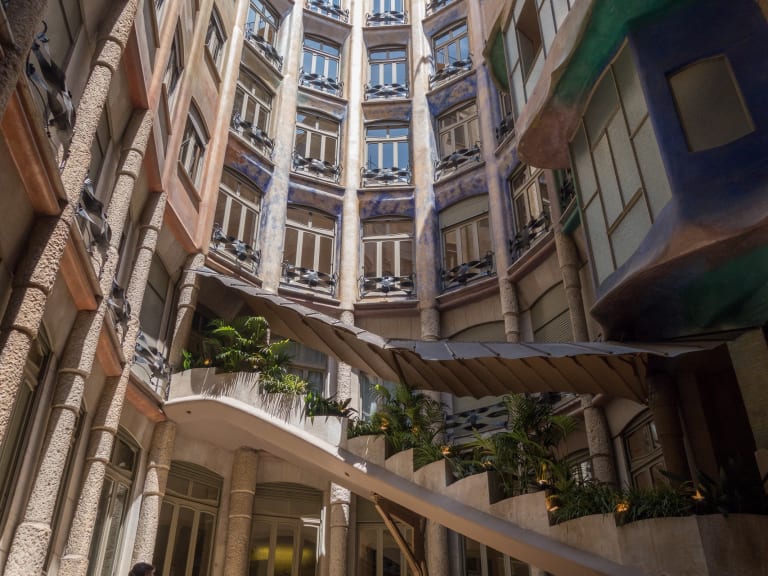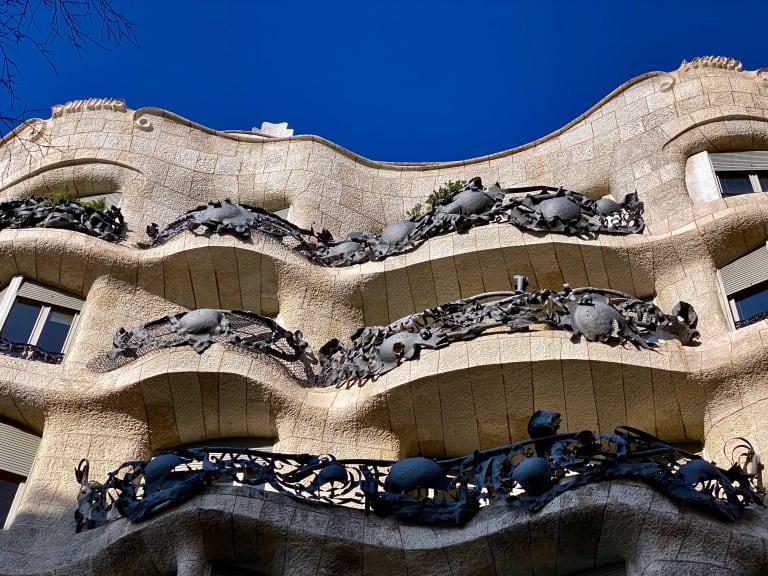More about: Things You Can´t Miss at La Pedrera Barcelona
Considered by experts as the most emblematic civil architecture building of Antonio Gaudí, a tour inside this important work is vital to understand the evolution of the important architect from Barcelona, as well as the best activities to do in Barcelona.
Gaudí built La Casa Milá (real name of the building) at the age of 57 between 1906 and 1912, being the last work he managed to complete before his death. Works such as La Sagrada Familia were left unfinished after his death.
So, if you already have your tickets to La Pedrera you will surely ask yourself: What is so wonderful about this building? What should I pay attention to when I decide to visit it? Below I give you all the details of what is, possibly, my favorite work in the whole city. I hope you enjoy it!
1. Access vestibules

Casa Mila is located on a corner lot so it has two main entrances, one on Paseo de la Gracia street and the other directly on the characteristic chamfer formed by the corners of the streets of Barcelona. The halls are spacious and full of light thanks to the presence of windows, a main door in iron and glass but above all the light that pours in from the interior courtyards.
The two foyers of La Pedrera function as a connection point for all the rooms of the complex. The majestic staircases connect directly to the main floor, which was originally designed as the home of the owners, Mr. and Mrs. Milá. The connection to the rest of the apartments and the roof is achieved through the elevators. Gaudí conceived the elevator as the main element of vertical communication, placing additional stairs mainly for service use.
2. The crown of the building: the roof terraces

The rooftop terrace of Casa Mila is unlike anything you've ever seen. Here Gaudí conceived an open space straight out of a fantasy novel. The Spanish poet Pere Gimferrer described this place as "the garden of warriors" because of the 28 chimneys and whose curved shapes look nothing like conventional chimneys but rather resemble imposing masked warriors.
On the rooftop, the undulating floors give way to steps and slopes, so during the tour I recommend paying close attention to your feet, although this is difficult because wherever you look you will come across sculptural and architectural details that will captivate your attention.
In addition to the winding paths, thousands of pieces of broken marble and tiles of Valencia serve to cover several of the sculptures chimneys because during the night the roof is illuminated in a spectacular way with the lighting of the roof lights.
As if all this were not enough, from the fabulous terrace you get some of the best views of Barcelona.
3. The whale's attic and the Gaudí exhibition

Many might think whether or not it is interesting to visit the attic of a building, but when talking about a Gaudi building the answer will always be positive. Named the attic of the whale, in Gaudi's initial plan this space was conceived to house the service and laundry rooms of the building. However, a service area is not synonymous with a relegated or second-class space, quite the contrary.
Currently the attic space serves as a museum, so in addition to admiring the structure, you can enjoy the Espai Gaudí collection dedicatedentirely to the work of the architect. Here you can find dozens of models and plans of his most famous works as well as spectacular plaster models made to scale to study the facade and structure of the Casa Mila.
4. The courtyard system and its conceptual load

The system of interior courtyards created by Gaudí served as a rather ingenious architectural solution that helped to solve the ventilation and lighting problem of the free-standing building blocks. Two interior courtyards, one smaller and one larger, rise from the first floor level directly to the roof. Entering these spaces and looking up to the sky is a delight to the senses; let's take a look at the qualities of each.
The courtyard of flowers
The main and decidedly peculiar feature of the Patio de las Flores is, without a doubt, its use of color. This space is accessed through the entrance hall facing Paseo de Gracia street.
If you come from outside you will quickly notice that a play of shapes, colors and lights offers a spectacle that clearly contrasts with the chromatic sobriety that characterizes the facade of La Casa Mila. The Patio de las Flores has a floor plan of 90 meters, making it the smaller of the two.
The courtyard of butterflies
The Patio of the Butterflies speaks of nature and life in motion, this being its most outstanding quality. The structure itself is made up of numerous sculptural forms that evoke creatures of nature: a huge butterfly perched on the entrance threshold or a large wing of some insect of impossible dimensions wraps the staircase leading up to the main floor. The butterfly courtyard is the larger and more imposing of the two with its 150 m2, located behind the lobby that connects to Provenca Street.
5. The basement, an unprecedented innovation!

Following a similar pattern of organic forms, Gaudí conceived this space as a garage, where the carriages and automobiles that the owner of the project was already fond of could be stored. Access to the basement is through the two main halls via helical ramps and this space is currently used as an auditorium.
Leaving aside the curved forms, it may seem to us in modern times that the basement of the pedrera is a common spatial solution in a residential building. However, it is vitally important to understand the historical context in which this project was built. In 1912 there was no similar solution anywhere in the world, the need to dedicate a space for the shelter of a vehicle was not conceived; this only evidenced over the years how ahead of its time was the work and the ingenuity of Gaudí being able to reflect on the needs of modern life and put himself in front of them.
6. The structural system and the use of materials

In your tour of La Pedrera always try to pay attention to the structural solutions that Gaudí provided to the different problems of the building. From stone pillars, brick or iron, he did not skimp on the use of materials that allowed him to provide the best possible solution in each scenario.
On your tour you will notice that the interior distribution of the different rooms stands out for its free geometry. The absence of load-bearing walls results in interchangeable spaces that can be adapted to the tenant's needs. The optimization of the facade as a structural system makes it possible to distribute the loads without overloading the interior spaces.
In the attic or loft area Gaudí used all his ingenuity to create a framework of 270 parabolic brick arches whose strength serves to support the roof located just above.
7. The floor of the neighbors and the custom-made furniture

The fourth floor of the building houses what is known as "The neighbors' apartment"; the only apartment in the entire building whose design and furnishings to this day (more than 100 years later) remain as Gaudí designed them.
Pere Milà lived in this apartment with his family for decades. The interior remains in an impressive state of preservation so that a tour of its rooms is similar to a trip back in time in which you can appreciate the way the upper class of Barcelona lived at the beginning of the last century. It is disturbing and wonderful to see how, despite the passage of time, even the children's toys seem to have been frozen in time.
On your visit pay special attention to the custom-made furniture designed by Gaudí; authentic pieces of art of the modernist movement.
8. The entrance doors

Access to the foyers of Casa Mila is achieved through wrought iron gates whose appearance serves only to emphasize the unique language of Gaudi's work. This same style was followed in all the balconies that interact with the main façade and other balustrades inside the building.
Their organic design evokes natural forms, from butterfly wings to turtle shells; the combination of materials such as iron and glass serves several purposes: first as an element of protection from the exterior and second as a natural lighting resource that allows the lobby space to be bathed in light.
9. The paintings and murals

Inside the Casa Mila it is possible to find some artistic works typical of the modernist movements popular at the time. This intention can be appreciated in the lobbies, where you can enjoy the work of the artist Aleix Clapés. His work for Gaudí's work follows themes of mythological inspiration and although it has undergone several restorations it is still fabulously preserved. Pay special attention to the murals on the staircases that communicate the access floor with the main floor of the building.
It is important to understand that Gaudí's architecture did not seek excessive adornment of the walls through conventional plastic works such as paintings; Gaudí preferred the integration of art directly into the form with the combination and use of different materials to express his creative language.
10. The façade is a faithful example of Gaudí's style

Whether on your arrival or departure, it is mandatory that you take a moment to analyze the most striking, singular and eye-catching element of the building: its imposing façade. The facade, completely in stone and with undulating shapes, made it a highly controversial design for the time and aroused the displeasure of many of his contemporaries. The nickname La Pedrera was born precisely from the mockery of those who at the time considered it an ugly and unpleasant building.
The Casa Mila is considered an innovative work mainly because of its all-steel structure and the use of curtain walls mainly in its self-supporting facade. In addition to the use of undulating stone to create unique organic forms, the addition of wrought iron is present in the imposing entrance doors (which also use glass), in the balusters of the balconies and in the windows that look directly onto the streets.
This was the last work of civilian character that the architect built before focusing entirely on the design and construction of the Sagrada Familia, so in La Pedrera you can see the full maturation of his peculiar style. Gaudí manages to leave us an artificial building that beautifully imitates nature.




